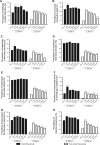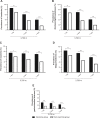Sleep quality changes in insomniacs and non-insomniacs after acute altitude exposure and its relationship with acute mountain sickness
- PMID: 25114534
- PMCID: PMC4124070
- DOI: 10.2147/NDT.S67218
Sleep quality changes in insomniacs and non-insomniacs after acute altitude exposure and its relationship with acute mountain sickness
Abstract
Objective: We aimed to observe the changes in subjective sleep quality among insomniacs and non-insomniacs after acute ascending to 3,700 m and its possible relationship with acute mountain sickness (AMS).
Methods: A total of 600 adult men were recruited. Subjects' subjective sleep quality was evaluated by the Athens Insomnia Scale. AMS was assessed using the Lake Louise scoring system. Arterial oxygen saturation was measured.
Results: Despite insomnia resolution in only a few subjects, the prevalence of insomnia among insomniacs remained stable at 90% after rapid ascent to 3,700 m. However, among non-insomniacs, the prevalence of insomnia sharply increased to 32.13% in the first day of altitude exposure and progressively reduced to 4.26% by the 60th day of altitude stay. Moreover, the prevalences of insomnia symptoms decreased more markedly from day 1 to day 60 at 3,700 m among non-insomniacs than among insomniacs. At 3,700 m, the prevalence of AMS among insomniacs was 79.01%, 60.49%, and 32.10% on the first, third, and seventh days, respectively, which was significantly higher than that among non-insomniacs. Multivariate regression revealed that elevated Athens Insomnia Scale scores are an independent risk factor for AMS (adjusted odds ratio 1.388, 95% confidence interval: 1.314-1.464, P<0.001), whereas high arterial oxygen saturation and long duration of altitude exposure are protective factors against AMS.
Conclusion: Our results suggest that the effect of high-altitude exposure on subjective sleep quality is more marked, but disappears more quickly, among non-insomniacs than among insomniacs, whereas AMS is especially common among insomniacs. Moreover, poor subjective sleep quality is a risk factor for AMS.
Keywords: Athens Insomnia Scale; arterial oxygen saturation; rapid ascent; sleep.
Figures




Similar articles
-
Age as a risk factor for acute mountain sickness upon rapid ascent to 3,700 m among young adult Chinese men.Clin Interv Aging. 2014 Aug 6;9:1287-94. doi: 10.2147/CIA.S67052. eCollection 2014. Clin Interv Aging. 2014. PMID: 25120358 Free PMC article.
-
Does change in barometric pressure per given time at high altitude influence symptoms of acute mountain sickness on Mount Fuji? A pilot study.J Physiol Anthropol. 2021 May 7;40(1):6. doi: 10.1186/s40101-021-00256-y. J Physiol Anthropol. 2021. PMID: 33962688 Free PMC article.
-
Correlation between blood pressure changes and AMS, sleeping quality and exercise upon high-altitude exposure in young Chinese men.Mil Med Res. 2014 Aug 26;1:19. doi: 10.1186/2054-9369-1-19. eCollection 2014. Mil Med Res. 2014. PMID: 25722875 Free PMC article.
-
Association between physiological responses after exercise at low altitude and acute mountain sickness upon ascent is sex-dependent.Mil Med Res. 2020 Nov 5;7(1):53. doi: 10.1186/s40779-020-00283-3. Mil Med Res. 2020. PMID: 33148321 Free PMC article.
-
The 2018 Lake Louise Acute Mountain Sickness Score.High Alt Med Biol. 2018 Mar;19(1):4-6. doi: 10.1089/ham.2017.0164. Epub 2018 Mar 13. High Alt Med Biol. 2018. PMID: 29583031 Free PMC article.
Cited by
-
Association between smoking and the risk of acute mountain sickness: a meta-analysis of observational studies.Mil Med Res. 2016 Dec 8;3:37. doi: 10.1186/s40779-016-0108-z. eCollection 2016. Mil Med Res. 2016. PMID: 27980800 Free PMC article.
-
Differences in Tolerance to Hypoxia: Physiological, Biochemical, and Molecular-Biological Characteristics.Biomedicines. 2020 Oct 18;8(10):428. doi: 10.3390/biomedicines8100428. Biomedicines. 2020. PMID: 33080959 Free PMC article. Review.
-
Sleep at high altitude: A bibliometric study and visualization analysis from 1992 to 2022.Heliyon. 2023 Nov 29;10(1):e23041. doi: 10.1016/j.heliyon.2023.e23041. eCollection 2024 Jan 15. Heliyon. 2023. PMID: 38163230 Free PMC article.
-
The onset of sleep disturbances and their associations with anxiety after acute high-altitude exposure at 3700 m.Transl Psychiatry. 2019 Jul 22;9(1):175. doi: 10.1038/s41398-019-0510-x. Transl Psychiatry. 2019. PMID: 31332159 Free PMC article.
-
Acute Altitude Acclimatization in Young Healthy Volunteers: Nocturnal Oxygenation Increases Over Time, Whereas Periodic Breathing Persists.High Alt Med Biol. 2021 Mar;22(1):14-23. doi: 10.1089/ham.2020.0009. Epub 2020 Nov 12. High Alt Med Biol. 2021. PMID: 33185483 Free PMC article.
References
-
- Fang J, Wheaton AG, Keenan NL, Greenlund KJ, Perry GS, Croft JB. Association of sleep duration and hypertension among US adults varies by age and sex. Am J Hypertens. 2012;25(3):335–341. - PubMed
-
- Imray C, Wright A, Subudhi A, Roach R. Acute mountain sickness: pathophysiology, prevention, and treatment. Prog Cardiovasc Dis. 2010;52(6):467–484. - PubMed
-
- Roach RC, Bartsch P, Hackett PH, Oelz O. The Lake Louise acute mountain sickness scoring system. In: Sutton JR, Houston CS, Coates G, editors. Hypoxia and Molecular Medicine. Burlington, VT: Queen City Press; 1993. pp. 272–274.
-
- Bärtsch P, Swenson ER. Acute high-altitude illnesses. N Engl J Med. 2013;368(24):2294–2302. - PubMed
LinkOut - more resources
Full Text Sources
Other Literature Sources

